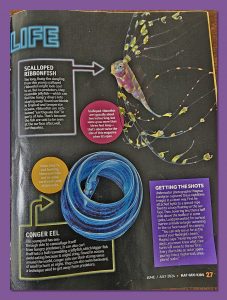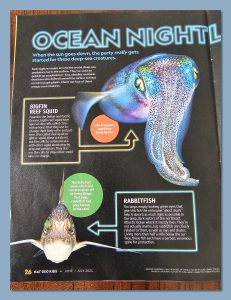As the bright fiery ball of light disappears from view, mysterious, shadowed creatures appear from hiding. Their glowing, neon lights illuminate in the darkness. Explore animals’ features and characteristics, like the bigfin reef squid, conger eel, and more. These underwater beings go incognito at day and reveal themselves when the world above goes into a deep slumber.
Firstly, we have the bigfin reef squid, which looks as vibrant as a rainbow in contrast to the darkness of the dark sea. They’re also referred to as oval squid or glitter squid. The reason for their color is because they have chromatophores, or unique skin cells, they can use to alter their body color and design. These can also be used for communicating with other squid and warning them about predators or informing them about prey arriving. Not only that, but it has 3 hearts, just like a regular octopus.
Next up is the rabbitfish, which abides in the Atlantic Ocean. It’s given the nickname “ghost shark,” but it’s not an actual shark-it’s just related to it. It has a venomous spine to protect itself and absorbs a lot of light with its green, vacant eyes. It’s hard to find prey in the dark, so the rabbitfish senses electrical currents that other living things give off.
Scalloped ribbonfish actually resembles its name. It has dangling, slender, long fins that are typically 2 inches long, but they can even become an astonishing 3 feet. These ribbon-like fins guard the fish from predators, as they appear to be jellyfish. Since jellyfish can sting with their tentacles, predators are more likely to stay away from them. Scalloped ribbonfish are usually found in tropical oceans and are seen at the surface are earthquakes several times. That’s why they’re nicknamed the “earthquake fish.”
The majestic conger eel can be found scattered in oceans across the world. It has transparent skin, which aids in camouflaging itself, or blending into its surroundings. It can look like a jellyfish, just like the scalloped ribbonfish, except it has to roll into a ball to frighten predators. Another technique for surviving from predators for it is swimming backwards. Its enhanced sense of smell helps it scavenge for its quarry, but when it isn’t hunting, it hides in various places from caves to shipwrecks.
Knowing about these animals is remarkable, and getting to see how they look is pleasurable, but how are these photos taken? Magnus Lundgren, the photographer, put lights on a rope attached to a buoy floating above the surface. Next, he waited for mysterious, phenomenal, sea creatures to arrive near the camera and drifted a few feet above the seafloor. This is a brilliant idea, as it not only assures beautiful, confounding critters to be found, but it also helps capture the animal’s picture correctly to study it and show it to other people.
To sum it up, all of these organisms are marvelous and amazing with their own different traits and survival tactics to find food and be safe from predators. However, there is only so much ocean we can cover, and there’s definitely more to explore. Who knows how deep the ocean is? There can be many interesting, intriguing creatures to explore lower into the ocean, and we don’t know about them. Despite that, we still have seen numerous colorful, wonderous ones, like my personal favorite, the glitter squid.
Written by Kruti Patel


